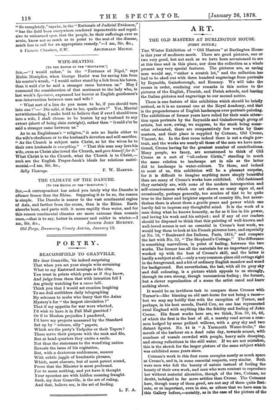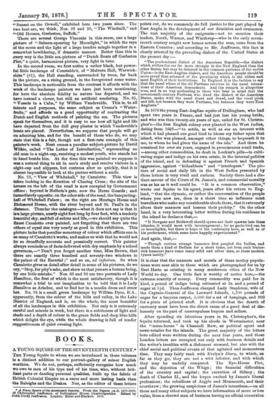ART.
THE OLD MASTERS AT BURLINGTON HOUSE. [FLRST NOTICE.]
TUE Winter Exhibition of "Old Masters" at Burlington House. is this year of mediocre merit. There are good pictures, one or two very good, but not such as we have been accustomed to see at this time and in this place, nor does the collection as a whole- present any very special features. The pictures are, as racing men would say, "rather a scratch lot," and the collection has had to be eked out with three hundred engravings from portraits by Reynolds, Gainsborough, and Romney. We will take the rooms in order, confining our remarks in this notice to the pictures of the English, Flemish, and Dutch schools, and leavIng the Italian pictures and engravings to our second notice.
There is one feature of this exhibition which should be briefly noticed, as it is an unusual one at the Royal Academy, and Oat is the preponderance of English landscapes over portrait-paintiag. The exhibitions of former years have relied for their main attrue- tion upon portraits by the Reynolds and Gainsborough group.9f artists, but now, owing, we suppose, to the stock being sown- what exhausted, there are comparatively few works by these
masters, and their place is supplied by Cotman, Old Crome, Vincent, &c. In the first room indeed there is not a single por- trait, and the works are nearly all those of the men we have men- tioned, Crome having far the greatest number of contributions.. Many people, we fancy, are accustomed to think of Old Crome as a sort of "oil-colour Girtin," standing in much the same relation to landscape art in oils as the latter did to landscape in water-colours. To those, and indeed to most of us, this exhibition will be a pleasant surprise, for it is difficult to imagine anything more simply beautiful than are many of Crome's works here exhibited. Old-fashioned they certainly are, with none of the modern introspection and self-consciousness which our art shows so many signs of, and occasionally, perhaps generally, too sombre of tint to be quite true to the fairer and brighter aspects of country life, but never- theless there is about them a gentle peace and power which can hardly fail to impress any thoughtful mind. It is the work of a man doing what he knows honestly, as far as it lies in his power, and loving his work and his subject ; and if any of our readers- should be disposed to think that this painting of well-known, and well-loved scenes is not an essential in Crome's best work, we would beg them to look at his French pictures here, and especially at No. 18, "Boulevard des Italiens, Paris, 1814," and compare the last with No. 32, "The Shepherd's Cottage." The difference is something marvellous, in point of feeling, between the two, works. The former has all the materials for an important picture, worked up with the best of Crome's skill, and the latter is hardly a subject at all,—only a very common-place old cottage right in the foreground, and a bit of ordinary English meadow and wood for background. But nevertheless, the last, with all its grey sky and dull colouring, is a picture which appeals to us strongly, through its own strong, though unconscious feeling ; the former, but a clever reproduction of a scene the artist cared and knew nothing about.
It would be an invidious task to compare these Cromes with Turner's—like blaming an old cart-horse for not being a racer— but we may say boldly that with the exception of Turner, and perhaps, in his best moods, David Cox, no one has represented rural England with anything like the fidelity and feeling of John Crome. His finest works here are, we think, Nos. 39, 44, 48, of which the first is the beat of all, a marshy road across a com- mon hedged by some pollard willows, with a grey sky and two distant figures. No. 44 is "A Yarmouth Water-frolic," the mouth of the harbour on a dead calm day, towards sunset, with numbers of vessels crowded with people, heavy sails drooping, and strong reflections in the still water. If we are not mistaken, this is the sketch for the larger picture of the same subject which was exhibited some years since.
Cotman's work in this first room occupies nearly as much space as Crome's, and is, in some essential respects, very similar. Both were men who felt the beauty of nature instead of feeling the beauty of their own work, and men who were content to reproduce her without material alteration, though of the two, Cotman, no doubt, indulged in far more artifice than Crome. The Cotmans here, though many of them good, are not any of them quite first- rate, or so important, even in size, as others that we have seen in this Gallery before,—notably, as in the case of the picture of the 4g Sunset on the Orwell," exhibited here two years since. The two best are, we think, Nos. 29 and 30, "The Windmill," and 4g Old Houses, Gorleston, Suffolk."
There are several George Vincents in this room, one a large picture of "Salmon-spearing by Moonlight," in which the rays of the moon and the light of a large bonfire mingle together in a somewhat bewildering, if dramatic manner. Better than this in every way is the little sea-picture of "Dutch Boats off Gorleston Pier," a quiet, harmonious picture, very light in tone.
In the second room, we first notice a rather black, but power- ful little landscape of Constable's, of "Malvern Hall, Warwick- shire" (61), the Hall standing, surrounded by trees, far back in the picture, on a rising ground, in the foreground some water. This landscape is noticeable from the contrast it affords with the work of the landscape painters we have just been mentioning, for here the absolute fidelity to nature has departed, and we have instead a clever, but still an artificial rendering. No. 65, "Vessels in a Calm," by William Vartdevelde. This is, to all -intents and purposes, the same subject as Crome's "Water- frolic," and affords us a good opportunity of contrasting the Dutch and English methods of painting the sea. The pictures speak for themselves, and it is easy to see how all light and life have departed from the dull grey plaster in which Vandevelde's boats are placed. Nevertheless, we suppose that people will go -on admiring him, and for the benefit of those who do, we may state that this is a fair, though not a first-rate example of this 42ainter's work. Next comes a peculiar subject-picture by David Wilkie, called "The Letter of Introduction," representing an Old man in a night-cap, receiving a modest youth, who stands hat in hand beside him. At the time this was painted we suppose it was a natural thing to sit in one's study and receive visitors in a might-cap and slippers, but customs alter so quickly, that it is almost impossible to look at the picture without a smile.
No. 73, "View of Whitehall," by Canaletto. This view is taken looking in the direction of Charing Cross ; the site of the tenses -on the left of the road is now occupied by Government offices ; beyond is Holbein's gate, now the Horse Guards ; and imMediately opposite, on the other side of the road, the banqueting- hail of Whitehall Palace ; on the right are Montage House and Richmond House, with the river beyond and St. Paul's in the distance. Thus far the catalogue—what it does not say is that it bra large picture, nearly eight feet long by four feet, with a tenderly beautiful sky, and full of colour and life,—we should say quite the finest Canaletto ever painted, not forgetting that there are two -others of equal size very nearly as good in this exhibition. This picture lacks that peculiar monotony of colour which afflicts one in -s0 many of Canaletto'a works, and makes us wish that he would not be so dreadfully accurate and prosaically correct. This painter alivays reminds us of facts delivered with dry emphasis by a school governess,—" Don't you forget another time, Miss Brown, that there are exactly three hundred and seventy-two windows in the palace of the Escurial ;" and so on, ad infinitum. So when Canaletto gives us detail after detail in some of his pictures, do we cry, "Stop, for pity's sake, and show us that you are a human being, by one little mistake." Nos. 83 and 92 are two portraits of Lady Hamilton, the first of which is the most satisfactory, though it is somewhat a trial to our imagination to be told that it is Lady Hamilton as Ariadne, and to find her in a muslin dress and straw hat. No. 94 is a small green landscape by William Dyce, R.A., apparently, from the colour of the hills and valley, in the Lake District of England, and is, on the whole, the most beautiful of all the landscapes in this exhibition. Not only is it extremely careful and minute in work, but there is a subtleness of light and shade and a depth of colour in the green fields and deep blue hills which delight the eye, while the whole drawing is full of tender .stiggestiveness of quiet evening light.



































 Previous page
Previous page